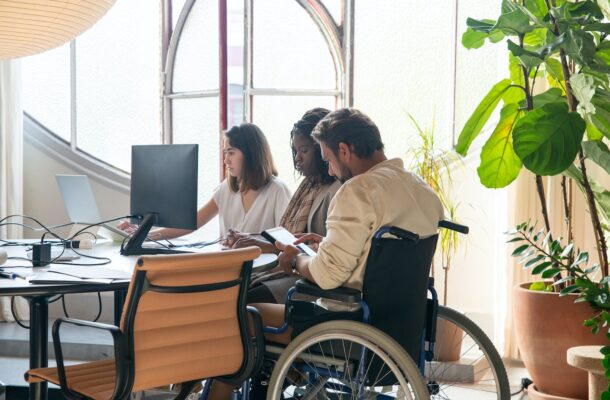A helping hand

Sometimes people aren’t sure how to socially interact with a person with a disability, making the encounter feel awkward or forced. Humans are social creatures, and this lack of connection can be very detrimental to the one being alienated.
Here are five actionable strategies everyone can adopt to make our society more inclusive regardless of the type of disability encountered.
Direct communication
One of the most common slip-ups that typically-abled people make is talking over the heads of people with disabilities, especially when said person is accompanied by a third party. If we are to create a genuinely inclusive and diverse environment we must make a point of communicating directly, respectfully, and on equal ground.
When asking a question or having any kind of conversation, address the person with the disability directly. Don’t ignore them in favour of their family member, friend, nurse, or Disability Support Worker. Even if they’re there in the role of carer, the person with the disability is still their own decision maker.
Respecting space and property
It’s important to maintain the same sense of space when interacting with a person with a disability as we do when interacting with a person without one. To begin with, it’s essential to mind one’s proximity. People unconsciously tend to come nearer, unnecessarily speak louder, etc. This is an invasion of the disabled person’s space, as well as an attack on their senses. Moreover, it’s overbearing and demeaning.
Maintain the same distance you commonly do when conversing, shaking hands, demonstrating something, etc. If they need you to come closer or speak up, rest assured they will let you know in a way that suits them.
Likewise, do not under any circumstance interfere with their equipment. Don’t attempt to drive their chairs or lean on them, don’t attempt to remove the noise-cancelling headphones they might be wearing to deal with auditory overwhelm, etc.
This especially applies to mobility aids. Equipment like mobility chairs, walkers, canes, crutches, etc. are considered for all intents and purposes a direct extension of the person’s body. You wouldn’t randomly grab at a stranger’s legs in the street, so don’t mess with people’s mobility aids either. It’s perceived as indescribably rude, and may even be construed as assault.
Diversifying support services
If you have a friend or family member with a disability and would like to provide them with NDIS services, make sure they undergo an accurate functional capacity assessment before you actually make any plans.
Discuss with the staff what kind of assessments need to be done: physical functional capacity, mental functional capacity, independent living ability, etc. You will likely work with an Occupational Therapist and possibly a mental health professional.
Support services function best when they’re tailored to the needs of the individual. Even people with the same disability will need different types and levels of support. Trying to treat them all the same isn’t helpful; in fact, it’s counterproductive and demoralising.
The same holds true regarding support outside of healthcare institutions. Employers, service workers, administrators, neighbours, everyone needs to be willing to support an individual with a disability according to their specific circumstances, rather than one’s own expectations.
Avoiding unprompted assistance
A person with a disability (including non-obvious disabilities) doesn’t necessarily need or want to be helped. There’s that adage about the road downhill being paved in the best of intentions. Refrain from jumping to conclusions and acting on the assumption that a person with a disability must want or need assistance.
Do help if asked; otherwise, don’t get underfoot. It sends the dehumanising message that you consider the person to be incapable of doing whatever it is that they’re doing, or, at the very least, being notably less capable than your typically-able self.
Nobody likes to be made to feel less. Unsolicited assistance takes control away from the person with a disability and removes their capacity for independent choice. It’s a very hurtful and damaging idea to imply.
Educating the new generation
Finally, to make sure the changes we’re making will persist into the future, we should prioritise inclusive education at all levels. Children are just as endlessly curious as they are receptive. Talk to them openly and in age-appropriate language about the various disabilities people have.
Do everything you can to dismantle stereotypes and outdated attitudes. Even if you don’t have children of your own, mind how you explain the existence of people with disabilities to young students, neighbourhood kids, young family members, etc.
Let them ask their questions, but teach them how not to be invasive about it. If they would directly ask a person with a disability about their condition, teach them to ask permission first and to accept “No” for a final answer.
Above all, instil in the youth in your life the understanding that people with disabilities are their equals, fellow humans, to be respected and appreciated for who they are as people, not perceived as just their disabilities.
In summary, creating an inclusive society comes down to acknowledging the fundamental humanity of our peers with disabilities. Always strive to see the individual, not the condition. Accept their autonomy and abilities, don’t interfere in their decision-making, and teach your youth to do the same. From everyday interactions in the shops and streets, through professional healthcare, to legislation, inclusivity hinges on respect.
Derek Lotts is an experienced freelance writer and researcher. His main areas of interest are small business, home improvement, and sustainable living. He strongly believes in the power of sharing knowledge and ideas through the mediums of modern technology.












